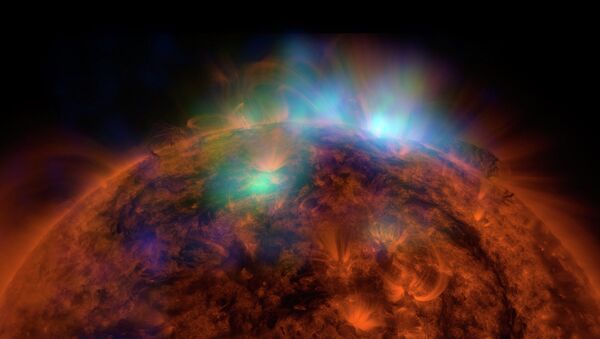The new model draws on dynamo effects in two layers of the Sun, one close to the surface and one deep within its convection zone. The model predicts a 60 percent fall in solar activity during the 2030s drawing a parallel with the mini ice age of 1645.
Prof Valentina Zharkova from the National Astronomy Meeting in Llandudno has recently presented the results on the research.
Until now there were no models to help explain fluctuations that differ from cycle to cycle.
Zharkova together with her colleagues were surprised by how much accuracy the second dynamo could add and predict a long-range scenario.
Experts say ☀️has nothing to do with climate 1950-1998, but caused Holocene Climate Optimum, Little Ice Age,19 yr 'pause' & new mini-ice age
— hockey schtick (@hockeyschtick1) July 11, 2015
Many scientists see convecting fluid deep within the Sun as a reason for the change in the solar cycle.
'We found magnetic wave components appearing in pairs, originating in two different layers in the Sun's interior,' Zharkova said. 'They both have a frequency of approximately 11 years, although this frequency is slightly different, and they are offset in time'.
'Over the cycle, the waves fluctuate between the northern and southern hemispheres of the Sun. Combining both waves together and comparing to real data for the current solar cycle, we found that our predictions showed an accuracy of 97%,' added Zharkova.
The solar scientists were based on 'principal component analysis' technique from the Wilcox Solar Observatory in California to devise the model. Three solar cycles-worth of magnetic field activity from 1976 to 2008 together with the data on average sunspot were put under scrutiny for the predictions and analysis to be matched.
The model says that the pair of waves will be increasingly offset during Cycle 25, peaking in 2022. From 2030 to 2040, during Cycle 6, the two waves will become exactly unmatched and this will lead to the huge solar activity decrease.
Irregularities in 11-year solar cycle actually result from two separate dynamos #nam2015 https://t.co/6NMoA7nM5p pic.twitter.com/Du8vDg95Tm
— RAS (@RoyalAstroSoc) July 9, 2015
"Effectively, when the waves are approximately in phase, they can show strong interaction, or resonance, and we have strong solar activity. When they are out of phase, we have solar minimums. When there is full phase separation, we have the conditions last seen during the Maunder minimum, 370 years ago," said Zharkova.




